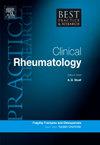轴型脊柱性关节炎影像学评估的最新进展。
IF 4.8
2区 医学
Q1 RHEUMATOLOGY
Best Practice & Research in Clinical Rheumatology
Pub Date : 2025-09-01
DOI:10.1016/j.berh.2025.102064
引用次数: 0
摘要
本更新介绍了过去5年来轴性脊柱炎影像学的新进展。这些主要集中在增强的CT和mri技术上,这些技术可以更精确地评估骶髂关节的炎症和结构性病变。国际共识推荐4序列MRI用于骶髂关节的常规诊断评估,旨在描述炎症的位置和程度,以及结构损伤的侵蚀敏感序列。后者包括高分辨率薄层序列,强调软骨下骨与上覆盖软骨和关节间隙之间的界面,以及合成CT,这是一种基于深度学习的技术,可将某些MRI序列转换为类似CT的图像。基于x线平片、CT和MRI数据集的深度学习算法在识别骶髂炎和骶髂关节和脊柱图像上观察到的单个病变方面越来越准确。本文章由计算机程序翻译,如有差异,请以英文原文为准。
Update of imaging in the assessment of axial spondyloarthritis
This update addresses new developments in imaging of axial spondyloarthritis from the past 5 years. These have focused mostly on enhanced CT and MRI-based technologies that bring greater precision to the assessment of both inflammatory and structural lesions in the sacroiliac joint. An international consensus has recommended a 4-sequence MRI for routine diagnostic evaluation of the sacroiliac joint aimed at depicting the location and extent of inflammation as well as an erosion-sensitive sequence for structural damage. The latter include high resolution thin slice sequences that accentuate the interface between subchondral bone and the overlying cartilage and joint space as well as synthetic CT, a deep learning-based technique that transforms certain MRI sequences into images resembling CT. Algorithms based on deep learning derived from plain radiographic, CT, and MRI datasets are increasingly more accurate at identifying sacroiliitis and individual lesions observed on images of the sacroiliac joints and spine.
求助全文
通过发布文献求助,成功后即可免费获取论文全文。
去求助
来源期刊
CiteScore
9.40
自引率
0.00%
发文量
43
审稿时长
27 days
期刊介绍:
Evidence-based updates of best clinical practice across the spectrum of musculoskeletal conditions.
Best Practice & Research: Clinical Rheumatology keeps the clinician or trainee informed of the latest developments and current recommended practice in the rapidly advancing fields of musculoskeletal conditions and science.
The series provides a continuous update of current clinical practice. It is a topical serial publication that covers the spectrum of musculoskeletal conditions in a 4-year cycle. Each topic-based issue contains around 200 pages of practical, evidence-based review articles, which integrate the results from the latest original research with current clinical practice and thinking to provide a continuous update.
Each issue follows a problem-orientated approach that focuses on the key questions to be addressed, clearly defining what is known and not known. The review articles seek to address the clinical issues of diagnosis, treatment and patient management. Management is described in practical terms so that it can be applied to the individual patient. The serial is aimed at the physician in both practice and training.

 求助内容:
求助内容: 应助结果提醒方式:
应助结果提醒方式:


